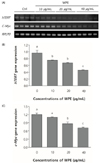1. Sabaté J, Ang Y. Nuts and health outcomes: new epidemiologic evidence. Am J Clin Nutr. 2009; 89:1643S–1648S.

2. Yu Z, Malik VS, Keum N, Hu FB, Giovannucci EL, Stampfer MJ, Willett WC, Fuchs CS, Bao Y. Associations between nut consumption and inflammatory biomarkers. Am J Clin Nutr. 2016; 104:722–728.

3. Calcabrini C, De Bellis R, Mancini U, Cucchiarini L, Stocchi V, Potenza L. Protective effect of Juglans regia L. walnut extract against oxidative DNA damage. Plant Foods Hum Nutr. 2017; 72:192–197.


4. Feldman EB. The scientific evidence for a beneficial health relationship between walnuts and coronary heart disease. J Nutr. 2002; 132:1062S–1101S.

5. Tsoukas MA, Ko BJ, Witte TR, Dincer F, Hardman WE, Mantzoros CS. Dietary walnut suppression of colorectal cancer in mice: mediation by miRNA patterns and fatty acid incorporation. J Nutr Biochem. 2015; 26:776–783.


6. Lee J, Kim YS, Lee J, Heo SC, Lee KL, Choi SW, Kim Y. Walnut phenolic extract and its bioactive compounds suppress colon cancer cell growth by regulating colon cancer stemness. Nutrients. 2016; 8:E439.

7. Rampazzo E, Bertorelle R, Serra L, Terrin L, Candiotto C, Pucciarelli S, Del Bianco P, Nitti D, De Rossi A. Relationship between telomere shortening, genetic instability, and site of tumour origin in colorectal cancers. Br J Cancer. 2010; 102:1300–1305.



8. Zhang C, Chen X, Li L, Zhou Y, Wang C, Hou S. The association between telomere length and cancer prognosis: evidence from a meta-analysis. PLoS One. 2015; 10:e0133174.

10. Rana C, Piplani H, Vaish V, Nehru B, Sanyal SN. Downregulation of telomerase activity by diclofenac and curcumin is associated with cell cycle arrest and induction of apoptosis in colon cancer. Tumour Biol. 2015; 36:5999–6010.


13. Choi J, Shin PK, Kim Y, Hong CP, Choi SW. Metabolic influence of walnut phenolic extract on mitochondria in a colon cancer stem cell model. Eur J Nutr. Forthcoming 2018.

14. Anderson KJ, Teuber SS, Gobeille A, Cremin P, Waterhouse AL, Steinberg FM. Walnut polyphenolics inhibit
in vitro human plasma and LDL oxidation. J Nutr. 2001; 131:2837–2842.

15. Min SJ, Lim JY, Kim HR, Kim SJ, Kim Y. Sasa quelpaertensis leaf extract inhibits colon cancer by regulating cancer cell stemness
in vitro and
in vivo. Int J Mol Sci. 2015; 16:9976–9997.

16. Cawthon RM. Telomere measurement by quantitative PCR. Nucleic Acids Res. 2002; 30:e47.

17. Hou M, Xu D, Björkholm M, Gruber A. Real-time quantitative telomeric repeat amplification protocol assay for the detection of telomerase activity. Clin Chem. 2001; 47:519–524.


18. Sadr M, Noori Mugahi SM, Hassanzadeh G, Nadji SA, Kiani A, Abedini A, Javadi A, Mohammadi F, Masjedi MR, Bahadori M. Telomere shortening in blood leukocytes of patients with chronic obstructive pulmonary disease. Tanaffos. 2015; 14:10–16.


19. Herbert BS, Hochreiter AE, Wright WE, Shay JW. Nonradioactive detection of telomerase activity using the telomeric repeat amplification protocol. Nat Protoc. 2006; 1:1583–1590.


22. Rozen S, Skaletsky H. Primer3 on the WWW for general users and for biologist programmers. Methods Mol Biol. 2000; 132:365–386.


23. Gilley D, Tanaka H, Herbert BS. Telomere dysfunction in aging and cancer. Int J Biochem Cell Biol. 2005; 37:1000–1013.


26. Ennour-Idrissi K, Maunsell E, Diorio C. Telomere length and breast cancer prognosis: a systematic review. Cancer Epidemiol Biomarkers Prev. 2017; 26:3–10.


27. Fang X, Hu T, Yin H, Yang J, Tang W, Hu S, Xu X. Differences in telomerase activity and the effects of AZT in aneuploid and euploid cells in colon cancer. Int J Oncol. 2017; 51:525–532.


28. Martin SL, Kala R, Tollefsbol TO. Mechanisms for the inhibition of colon cancer cells by sulforaphane through epigenetic modulation of microRNA-21 and human telomerase reverse transcriptase (hTERT) down-regulation. Curr Cancer Drug Targets. 2018; 18:97–106.

30. Lu Y, Leong W, Guérin O, Gilson E, Ye J. Telomeric impact of conventional chemotherapy. Front Med. 2013; 7:411–417.


31. Marfil V, Blazquez M, Serrano F, Castell JV, Bort R. Growth-promoting and tumourigenic activity of c-Myc is suppressed by Hhex. Oncogene. 2015; 34:3011–3022.








 PDF
PDF ePub
ePub Citation
Citation Print
Print




 XML Download
XML Download